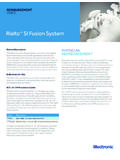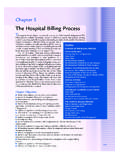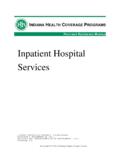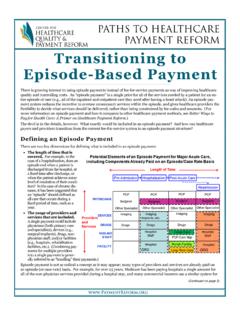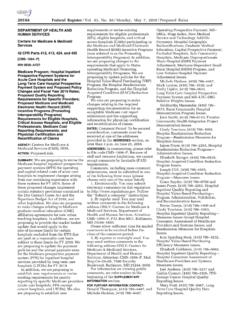Transcription of Hospital payment systems based on diagnosis-related …
1 Bull World Health Organ 2013;91:746 756A | doi: payment systems based on diagnosis -related groups: experiences in low- and middle-income countriesInke Mathauera & Friedrich WittenbecherbIntroductionA key factor for a more rapid move towards universal health coverage is the efficient use of resources, coupled with increased resource mobilization and improved pooling. Substantial ef-ficiency gains could be made by reforming Hospital payment mechanisms,1 especially since expenditure on Hospital services comprises one of the largest shares of total health-care spending in all countries, regardless of their income ,2 payment systems based on diagnosis -related groups (DRGs) are one type of such Hospital payment mechanisms, along with capitation payments , global budgets and a combina-tion thereof.
2 Although DRG- based payment systems are now mainly understood as a reimbursement mechanism, their origi-nal purpose was to enable performance comparisons across 5 Today DRGs are used primarily by purchasers to reimburse providers for acute inpatient care, but in principle they can also be used to reimburse them for non-acute inpa-tient care. By definition, DRGs classify cases according to the following variables: principal and secondary diagnoses, patient age and sex, the presence of co-morbidities and complications and the procedures performed. Cases classified as belonging to a particular DRG are characterized by a homogenous resource consumption pattern and, at the same time, DRGs are clinically meaningful.
3 Thus, cases within the same DRG are economically and medically ,3 DRG- based payment systems are often referred to as case- based or case-mix- based , yet DRG- based and case-mix- based payment systems are not the same. Even though the two overlap and are separated in practice by fluid boundaries, a DRG- based system is different in that it is based on a DRG grouping In fact, the two core design characteristics of a DRG- based payment system are: (i) an exhaustive patient case classification system ( the system of diagnosis -related groupings) and (ii) the payment formula, which is based on the base rate multiplied by a relative cost weight specific for each the 1990s, payments based on DRGs have gradually become the principal means of reimbursing hospitals for acute inpatient care in most high-income The most frequent reasons for introducing DRG- based payments are to increase efficiency and contain Street et al.
4 Have reviewed the little evidence that is available on the impact of different DRG- based payment systems in high-income countries in Their findings suggest that DRGs generally help to increase Hospital efficiency by reducing the average length of stay but that they also increase case , more and more low- and middle-income countries have begun to explore or have established DRG- based payment systems , mostly for the reimbursement of acute inpatient care. With the exception of country papers or manuals on how to introduce case- based payment and DRGs,5,7 there is no comprehensive overview of DRG practices in low- and middle-income countries.
5 This paper addresses this gap in the literature by being the first to provide a comprehensive overview and assessment of DRG experiences in low- and middle-income countries. Its purpose is to compile country experiences and to explore the design and implementation issues that low- and middle-income countries face. Ultimately it will be a source of policy lessons for policy-makers in other low- and middle-income countries who are deliberating on whether or not and, if so, how to move towards a DRG- based payment system . Because the evidence is scanty and impact evaluations are few, this paper cannot review the impact of DRG- based payment systems .
6 It can only provide illustrative examples of policy lever effects, primarily from countries that have already established a DRG- based payment This paper provides a comprehensive overview of Hospital payment systems based on diagnosis -related groups (DRGs) in low- and middle-income countries. It also explores design and implementation issues and the related challenges countries A literature research for papers on DRG- based payment systems in low- and middle-income countries was conducted in English, French and Spanish through Pubmed, the Pan American Health Organization s Regional Library of Medicine and Google. Findings Twelve low- and middle-income countries have DRG- based payment systems and another 17 are in the piloting or exploratory stage.
7 Countries have chosen from a wide range of imported and self-developed DRG models and most have adapted such models to their specific contexts. All countries have set expenditure ceilings. In general, systems were piloted before being implemented. The need to meet certain requirements in terms of coding standardization, data availability and information technology made implementation difficult. Private sector providers have not been fully integrated, but most countries have managed to delink Hospital financing from public finance Although more evidence on the impact of DRG- based payment systems is needed, our findings suggest that (i) the greater portion of health-care financing should be public rather than private; (ii) it is advisable to pilot systems first and to establish expenditure ceilings; (iii) countries that import an existing variant of a DRG- based system should be mindful of the need for adaptation.
8 And (iv) countries should promote the cooperation of providers for appropriate data generation and claims Department of Health systems Financing, World Health Organization, 20 avenue Appia, 1211 Geneva, 27, Department of Health Care Management, Technical University Berlin, Berlin, to Inke Mathauer (e-mail: 29 November 2012 Revised version received: 3 June 2013 Accepted: 6 June 2013 Published online: 6 August 2013 )Bull World Health Organ 2013;91:746 756A | doi: Hospital payment systems Inke Mathauer & Friedrich WittenbecherThe following section briefly outlines the methods and core design components that we followed in assessing countries experiences with DRG- based payment systems .
9 We subsequently present emerg-ing aspects and trends in the design and implementation of these systems . These and the challenges they entail are con-sidered in the discussion section, which is followed by a set of conclusions and policy lessons for other countries that are exploring the establishment of DRG- based payment 1 summarizes the core design com-ponents of DRGs, namely: (i) DRG vari-ant; (ii) cost weights; (iii) expenditure ceilings and (iv) adjustment factors. The figure also outlines how values can be set for these components and their potential effect as policy levers. We will explore country experiences in terms of these design components and the respective policy levers ( the possible effects of such design choices).
10 Importantly, the qualitative and quantitative effect of a DRG- based payment system is also con-tingent upon the payment mechanism that is issues are involved in the operation of a DRG- based payment sys-tem. Foremost, such a payment system creates unwanted incentives for increased Hospital admissions, up-coding ( the intentional and wrongful augmentation of case severity and thus reimbursement) and under-provision of necessary ,8 This occurs in all settings. Here, however, the focus is on implementa-tion issues that are critical in a low- or middle-income country: (i) the piloting of such a system ; (ii) problems with cod-ing standardization, data availability and information technology requirements; (iii) integration of the private sector, and (iv) Hospital conducted a search of the literature published from 1980 until Decem-ber 2012.










